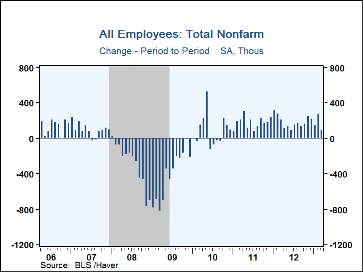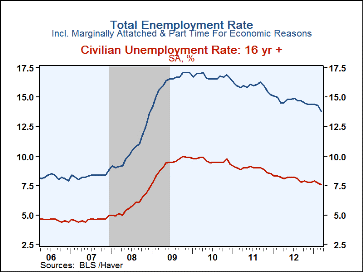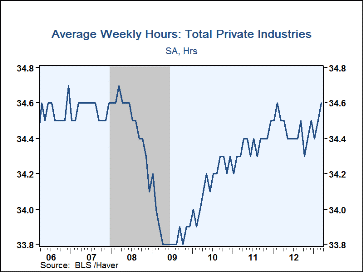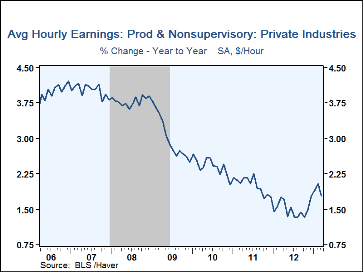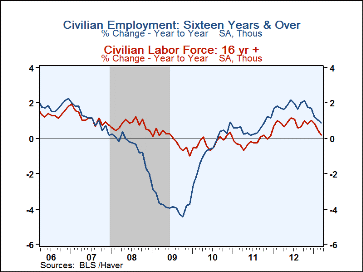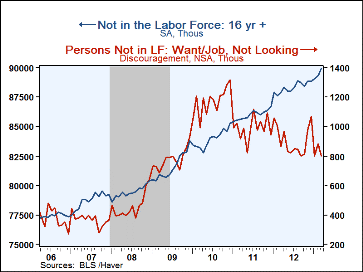 Global| Apr 05 2013
Global| Apr 05 2013U.S. Employment Gain Is Disappointing; Jobless Rate Continues To Slip
by:Tom Moeller
|in:Economy in Brief
Summary
The labor market grudgingly improved last month. Payroll employment increased 88,000 (1.4% y/y) following upwardly revised gains of 268,000 and 148,000 during the prior two months. Consensus had been looking for a 185,000 increase. [...]
The labor market grudgingly improved last month. Payroll employment increased 88,000 (1.4% y/y) following upwardly revised gains of 268,000 and 148,000 during the prior two months. Consensus had been looking for a 185,000 increase. Job growth across most sectors eased significantly. The March unemployment rate fell to a new cycle-low of 7.6%, the lowest since December 2008. A 7.7% rate had been expected. The rate on the broadest measure of unemployment, which includes marginally attached & those involuntarily working part-time, continued to trend lower to 13.8%.
The disappointing gain in payroll employment of 88,000 during March was the weakest rise in nine months. It was on a par with the gains logged before the recovery began in earnest. Factory sector payrolls declined by 3,000 (+0.6% y/y), led lower by a 7,000 decline (+0.2% y/y) in the nondurable goods area. Construction industry job growth amounted to just 18,000 (2.9% y/y), the weakest rise since October. The 79,000 (1.9% y/y) in private service sector payrolls was its weakest in nine months and roughly half the norm for this economic recovery. Employment fell in both wholesale (+1.6% y/y) and retail trade (+1.5% y/y). In leisure & hospitality businesses, employment rose just 17,000 (2.1% y/y), that's down by more than half from the monthly gains logged early last year. On the firm side, professional & business service jobs rose a respectable 51,000 (3.0% y/y) while job growth in education also was roughly stable at 27,900 (2.1% y/y). Government sector payrolls fell 7,000 (-0.3% y/y), although the February change was revised up from a decline to a gain of 14,000. Federal sector payrolls fell 14,000 (-1.7% y/y) in March as the effects of budget sequestration kicked in.
Average weekly hours worked continued to improve. The monthly jump to 34.6 hours last month brought the length of the workweek to its strongest in a year and the firmest of the economic recovery. Last month's surge occurred mostly in private services industries.
Earlier improvement in average hourly earnings has waned. Recent monthly changes have amounted to little and that's been enough to pull y/y growth to 1.8%, down from its recent peak of 2.1%. Earnings growth has been waning in education & health services (1.2% y/y) and financial activities (3.9% y/y). Improvement in factory sector (1.2% y/y) earnings growth remains in place.
In the household section of the employment report, the unemployment rate fell slightly to 7.6%, a new cycle low. That decline was accompanied by a sharp drop in the overall unemployment rate to 13.8%. Behind these lower rates was a 206,000 decline (+0.9% y/y) in employment and a 496,000 shortfall (+0.2% y/y) in the labor force. The number of working age individuals not in the labor force has surged to a record high (2.4% y/y). Long-term unemployment has become a lessened problem as the percentage of those unemployed for 52 weeks or more has shrunk to 25.6% from its high of 32.8% in early 2011. The median duration of unemployment has fallen to 17.1 weeks from its high of 25.8% in April 2010.
The figures referenced above are available in Haver's USECON database. Additional detail can be found in the LABOR and in the EMPL databases. The expectation figures are from Action Economics and are in the AS1REPNA database.
| Employment: (M/M Chg., 000s) | Mar | Feb | Jan | Y/Y | 2012 | 2011 | 2010 |
|---|---|---|---|---|---|---|---|
| Payroll Employment | 88 | 268 | 148 | 1.4% | 1.7% | 1.2% | -0.7% |
| Previous | -- | 235 | 119 | -- | 1.4 | 1.2 | -0.7 |
| Manufacturing | -3 | 19 | 14 | 0.6 | 1.7 | 1.7 | -2.7 |
| Construction | 18 | 49 | 24 | 2.9 | 2.0 | 0.3 | -8.3 |
| Private Service Producing | 79 | 181 | 123 | 1.9 | 2.2 | 1.9 | -0.1 |
| Government | -7 | 14 | -16 | -0.3 | -0.8 | -1.8 | -0.3 |
| Average Weekly Hours - Private Sector | 34.6 | 34.5 | 34.4 | 34.5 (Mar'12) |
34.4 | 34.4 | 34.1 |
| Average Private Sector Hourly Earnings (%) | -0.0 | 0.3 | 0.3 | 1.8 | 1.5 | 2.0 | 2.4 |
| Unemployment Rate (%) | 7.6 | 7.7 | 7.9 | 8.2 (Mar'12) |
8.1 | 8.9 | 9.6 |
Tom Moeller
AuthorMore in Author Profile »Prior to joining Haver Analytics in 2000, Mr. Moeller worked as the Economist at Chancellor Capital Management from 1985 to 1999. There, he developed comprehensive economic forecasts and interpreted economic data for equity and fixed income portfolio managers. Also at Chancellor, Mr. Moeller worked as an equity analyst and was responsible for researching and rating companies in the economically sensitive automobile and housing industries for investment in Chancellor’s equity portfolio. Prior to joining Chancellor, Mr. Moeller was an Economist at Citibank from 1979 to 1984. He also analyzed pricing behavior in the metals industry for the Council on Wage and Price Stability in Washington, D.C. In 1999, Mr. Moeller received the award for most accurate forecast from the Forecasters' Club of New York. From 1990 to 1992 he was President of the New York Association for Business Economists. Mr. Moeller earned an M.B.A. in Finance from Fordham University, where he graduated in 1987. He holds a Bachelor of Arts in Economics from George Washington University.


